Multiple Choice
Identify the
choice that best completes the statement or answers the question.
|
|
|
1.
|
Leader of North
Vietnam
a. | Mao
Zedong | c. | General
Jeip | b. | Chou | d. | Ho Chi
Minh |
|
|
|
2.
|
Communist group led by Ho Chi
Minh
a. | Vietcong | c. | Communist Little League | b. | Vietminh | d. | Commenterm |
|
|
|
3.
|
Eisenhower’s explanation
for what would happen if the U.S. did not stand up against communism. One nation would fall then
others would fall one after the other.
a. | domino theory
| c. | Theory of diminishing
returns | b. | NATO | d. | Vietnamization |
|
|
|
4.
|
Major French outpost captured
by the Vietminh. Last battle before the French were driven out of Vietnam.
a. | Little Big
Horn | c. | Saigon | b. | Dien Bien Phu | d. | Haiphong |
|
|
|
5.
|
Peace agreement that split
Vietnam in two
a. | Versailles
Treaty | c. | Geneva Accords
| b. | Treaty of the 18th
parallel | d. | Paris Peace
Treaty |
|
|
|
6.
|
Leader of South Vietnam he and
his family were assassination. Generals took over in South Vietnam after their
death
a. | Ngo Dinh Diem
| c. | Cahng Ki
Shek | b. | Ho Chi Minh | d. | Mao |
|
|
|
7.
|
Communist rebel group in South
Vietnam
a. | Vietwan | c. | Viet Legion | b. | Vietcong | d. | Vietsam |
|
|
|
8.
|
Network of paths running
between North and South Vietnam
a. | Viet Cong
Trail | c. | Vietnam
805 | b. | Cambodia Trail | d. | Ho Chi Minh Trail |
|
|
|
9.
|
Passed by congress, it gave
President Johnson the power to fight in Vietnam
a. | War Powers
Act | c. | Tonkin Gulf Resolution
| b. | Vietnam
Resolution | d. | Desert Storm
Resolution |
|
|
|
10.
|
This person was Secretary of
Defense under John Kennedy. When Johnson took over from Kennedy he kept the Kennedy foreign relations
team. He remained Secretary of Defense under Johnson and was responsible for the Vietnam war
strategy
a. | Bobby
Kennedy | c. | Walt
Rostow | b. | Robert McNamara | d. | Henry Kissinger |
|
|
|
11.
|
Another hold over from the
Kennedy administration the person was Secretary of State under Johnson and
Kennedy
a. | Dean Rusk
| c. | Robert
McNamara | b. | J. Edgar Hoover | d. | Walt Rostow |
|
|
|
12.
|
Commander of U.S. troops in
Vietnam
a. | Henry
Kissinger | c. | Wesley
Clark | b. | Curtis Lemay | d. | William Westmoreland |
|
|
|
13.
|
Gasoline-based explosive used
extensively in Vietnam
a. | black
powder | c. | napalm
| b. | co2 | d. | TNT |
|
|
|
14.
|
Chemical that destroyed jungle
foliage so Viet Cong would have no place to hide.
a. | Napalm | c. | Agent Blue | b. | DDT | d. | Agent Orange |
|
|
|
15.
|
Tactic in which U.S. troops
destroyed Vietnamese villages because the Vietcong was using them as hiding
places
a. | Vietnamization | c. | defoliation | b. | scorched earth policy | d. | search-and-destroy mission |
|
|
|
16.
|
The difference between the
government says and the truth. Often applied to the Johnson administration by the anti-war activists
during the Vietnam era
a. | misery
index | c. | credibility gap
| b. | conspiracy
gap | d. | truth index |
|
|
|
17.
|
Name given to the anti-war,
movement of the 1960’s
a. | New
Right | c. | Beatnicks | b. | New Left | d. | Liberals |
|
|
|
18.
|
Prominent group of the New Left
responsible for much of the anti-war activity on college campuses.
a. | Communist Party USA
(CPUSA) | c. | Youg
Republicans | b. | Young Americans for Freedom YAF | d. | Students for a Democratic Society SDS |
|
|
|
19.
|
New Left group that attacked
business and government - Originated in UC Berkley campus
a. | American Association
Manufactures | c. | Students for
Democratic Society SDS | b. | Free Speech Movement | d. | Young Americans for Freedom |
|
|
|
20.
|
Those Americans who called for
America to withdraw from Vietnam
a. | doves | c. | eagles | b. | hawks | d. | seals |
|
|
|
21.
|
Those Americans who supported
the war effort
a. | doves | c. | hawks | b. | donkey’s | d. | elephants |
|
|
|
22.
|
attacks during 1968 Tet holiday
that led many in America to believe that the U.S. could not win the war in
Vietnam
a. | Yom Kippur
war | c. | Tet
Retreat | b. | 6 day war | d. | Tet Offensive |
|
|
|
23.
|
Lyndon Johnson adviser who
became his secretary of defense after Robert McNamara quit
a. | Clark Clifford
| c. | Maxwell
Taylor | b. | George Ball | d. | Wm. Westmorland |
|
|
|
24.
|
Democratic candidate for
president in 1968. He decided to run after it looked like President Johnson could be beaten. He was
John Kennedy’s brother and a senator from New York.
a. | Teddy
Kennedy | c. | John Kennedy
Jr | b. | Robert Kennedy
| d. | William
Kennedy |
|
|
|
25.
|
Democratic presidential
candidate who ran on antiwar platform. He came close to beating President Johnson in the New Hampsire
primary and opened the way for others to get in th race..
a. | Clark
Clifford | c. | Eugene McCarthy
| b. | Hubert
Humphry | d. | Robert
Kennedy |
|
|
|
26.
|
1968 Democratic nominee for
president. He was President Johnson’s vice president and became the party favorite after Bobby
Kennedy was assassinated.
a. | Spiro
Agnew | c. | Eugene
McCarthy | b. | Hubert Humphrey | d. | William Westmorland |
|
|
|
27.
|
Third party candidate in 1968
presidential election He was a segregationist who ran as the American Independent Party candidate. He
was shot and paralysed during the election.
a. | George Wallace
| c. | Robert
Byrd | b. | Hubert Humphrey | d. | Orville Faubus |
|
|
|
28.
|
President Nixon’s plan
for ending America’s involvement in the war by turning it over to the Vietnamese
army.
a. | The Vietnam Master
Plan | c. | The Vietnimh
plan | b. | Vietnamization | d. | The Vietcong
plan |
|
|
|
29.
|
Those mainstream Americans who
supported Nixon’s policies. They did not demonstrate or make much political noise but they
voted in most elections.
a. | the mass
majority | c. | great unwashed
masses | b. | the quiet Americans | d. | silent majority |
|
|
|
30.
|
Government documents, stolen by
Daniel Elsberg, that showed the government had no real plan for leaving Vietnam. Anti-war
groups used them as proof that the Johnson administration was lying tothe
public.
a. | The White House
Briefs | c. | Pentagon Papers
| b. | The Warren
Report | d. | White House
Tapes |
|
|
|
31.
|
Nixon adviser who helped
negotiate an end to the war
a. | Henry Kissinger
| c. | Robert
McNamara | b. | Maxwell Taylor | d. | George Wallace |
|
|
|
32.
|
Communist group that took
control of Cambodia after the end of the Vietnam war. For some it proved the domino
theory.
a. | Cambodian
Vietcong | c. | Cambocong | b. | Khmer Rouge | d. | Comminterm |
|
|
|
33.
|
Law that forbids the president
from mobilizing troops without Congressional approval
a. | Anti-war
Act | c. | Anti-Vietnam
Act | b. | Congressional Authority Act | d. | War Powers Act Act |
|
|
|
34.
|
In the 1940s, which countries
troops, at one point or another,
occupied Vietnam?
a. | France and
Japan | c. | the United States and
France | b. | China and the Soviet Union | d. | the United States and the Soviet
Union |
|
|
|
35.
|
Which of the following was the
United States’ main goal in Vietnam?.
a. | the reunification of
Vietnam | c. | the upholding of
the Geneva Accords | b. | the containment of communism | d. | the negotiation of a cease-fire agreement with North
Vietnam |
|
|
|
36.
|
Which of the following
authorized President Johnson to conduct the war in Vietnam?
a. | the Geneva
Accords | c. | the War Powers
Act | b. | the Fulbright hearings | d. | the Tonkin Gulf Resolution |
|
|
|
37.
|
Which of the following served
as the commander of U.S. troops in Vietnam?
a. | Dean
Rusk | c. | Clark
Clifford | b. | Robert McNamara | d. | William Westmoreland |
|
|
|
38.
|
5. In the early years of the
war, a young man could be automatically deferred from the draft by
a. | enrolling in
college | c. | getting
married. | b. | becoming employed | d. | claiming to be a conscientious
objector |
|
|
|
39.
|
6. In the 1968 presidential
campaign, a dove would have been most likely to support
a. | George
Wallace | c. | Hubert
Humphrey | b. | Richard M. Nixon | d. | Eugene McCarthy |
|
|
|
40.
|
All of the following occurred
in 1968 except for the
a. | Tet
offensive. | c. | assassination of
Robert Kennedy | b. | invasion of Cambodia | d. | assassination of Martin Luther King,
Jr. |
|
|
|
41.
|
Which of the following did
President Nixon say would bring about “peace with honor” in Vietnam?
a. | the domino
theory | c. | the Vietnamization of the
war | b. | the Geneva Accords | d. | the Americanization of the war |
|
|
|
42.
|
9. Which of the following
events set off the first general student strike in U.S. history?
a. | the invasion of
Cambodia | c. | the assassination
of Martin Luther King, Jr. | b. | the assassination of Martin Luther King, Jr. | d. | the riots at the 1968 Democratic National
Convention |
|
|
|
43.
|
Congress passed the War Powers
Act in order to
a. | allow military leaders more
independence | c. | limit the
president’s authority to wage war | b. | prevent tragedies like the My Lai massacre | d. | increase the president’s authority to wage
war |
|
|
|
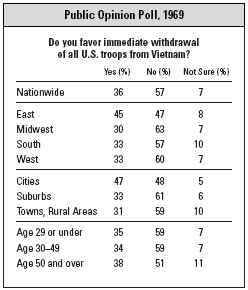 | In 1969, President Nixon proposed a gradual
withdrawal of U.S. troops from
Southeast
Asia. This public opinion poll shows what
Americans thought of the president’s
plan.
Use the chart to answer the questions below.
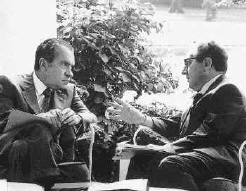
Richard Nixon and
Henry Kissinger | | |
|
|
|
44.
|
What percentage of
all Americans favored immediate
withdrawal of troops from Vietnam?
|
|
|
45.
|
Which section of the country
had the highest response in
support of Nixon’s policy?
a. | East | c. | Midwest | b. | South | d. | West |
|
|
|
46.
|
Was support for Nixon’s
policy stronger in the cities or in the suburbs?
|
|
|
47.
|
Which category of people was
least sure about troop
withdrawal?
a. | age 29 and
under | c. | age 50 and
over | b. | age 30-49 |
|
|
|
48.
|
Which nation did the United
States aid in its efforts to control Vietnam?
a. | Japan | c. | China | b. | France | d. | Britain |
|
|
|
49.
|
2. Which president asked
Congress for the Tonkin Gulf Resolution?
a. | Richard
Nixon | c. | John
Kennedy | b. | Lyndon Johnson | d. | Dwight Eisenhower |
|
|
|
50.
|
The main purpose of introducing the “body
count” was to
a. | persuade the Vietcong to
surrender | c. | build antiwar
sentiment in the United States | b. | motivate U.S. soldiers to desire revenge | d. | show that the war could not be won without U.S.
involvement. |
|
|
|
51.
|
Which of the following enabled
North Vietnam to supply it’s troops in South Vietnam?
a. | the Ho Chi Minh
Trail | c. | the strategic hamlet
program | b. | the fall of Dien Bien Phu | d. | Operation Rolling Thunder |
|
|
|
52.
|
Which of the following
statements regarding the Democratic candidates for president in the 1968 election is
true?
a. | Robert Kennedy was assassinated
after narrowly losing the party’s nomination. | c. | Eugene McCarthy voluntarily dropped out of the race before the national
convention took place | b. | Hubert Humphrey had the party’s nomination guaranteed before the
national convention took place. | d. | Lyndon B. Johnson announced at the national convention that he would not seek
the party’s nomination |
|
|
|
53.
|
The invasion of Cambodia
directly or indirectly led to all of the following except
a. | the repeal of the Tonkin Gulf
Resolution | c. | Nixon’s
decision to resign | b. | the first general student strike in U.S.
history | d. | the deaths of four students at Kent State
University. |
|
|
|
54.
|
Which president adopted the
policy of Vietnamization?
a. | Richard M.
Nixon | c. | John F.
Kennedy | b. | Lyndon B. Johnson | d. | Dwight D. Eisenhower |
|
|
|
55.
|
Which of the following was most
effective in leading the American public to conclude that the war was
unwinnable?
a. | body
counts | c. | the Tet
offensive | b. | the actions of the SDS | d. | the invasion of Cambodia |
|
|
|
56.
|
Which of the following were
long lasting effects of the Vietnam war?
a. | abolished the
draft | d. | demoralization of the American
spirit and poor morale | b. | War Powers Act to limit the president’s ability to make war on his
own | e. | all of these were lasting effects until the 1980’s
and the Reagan revival of the American spirit. | c. | Vietnam Syndrome which, some think, made the U.S.
apprehensive about asserting itself in foreign affairs |
|
|
|
The Roots of American Involvement
During the
1800”s and early 1900”s the countries of Europe had many colonies in Asia and Africa.
Indochina, including Vietnam, was a colony of France. During World War II the Japanese drove the
French out of Vietnam and occupied the country.
In the 1930’s the French owned many
plantations in Vietnam. They controlled the countries rice and rubber trade. Some peasants revolted
against the French which caused them to restrict free speech and other liberties of the peasant
population.
The Indochinese Communist Party, founded in 1930, organized most of the
uprisings. The_ party's leader was Ho Chi Minh Ho Chi Minh He was condemned to
death by the French in 1930 for his rebellious activity and fled Vietnam that year and went in exile
in the Soviet Union and China. However, throughout the 1930s, Ho Chi Minh orchestrated Vietnam's
growing independence movement from exile.
When Japan took control of Vietnam in 1940, Ho Chi
Minh returned home to fight the Japanese..The Vietnamese Communists combined with other nationalist
groups to form an organization called the Vietminh. The group sought Vietnam's
independence from foreign rule. When the Allied defeat of Japan in August of 1945 it forced the
Japanese to leave Vietnam. On September 2, 1945, Ho Chi Minh stood in the middle of a huge crowd in
the northern city of Hanoi and declared Vietnam an independent nation.
| |
|
|
|
57.
|
Why did the Vietnamese revolt
against the French?
a. | They wanted more money for their
crops | c. | They wanted to be
communist | b. | They wanted Japan to win World War II | d. | They wanted to free their country from French rule and gain their civil
rights |
|
|
|
58.
|
Ho Chi Minh was a
.....
a. | Communist | c. | French Socialist | b. | Capitalist | d. | Japanese Fascist |
|
|
|
59.
|
What was the name of the
organization that was formed to fight the Japanese occupation of Vietnam during World War
II?
a. | Ho Chi
Vietminh | c. | Vietcong | b. | Foreign Legion | d. | Vietminh |
|
|
|
60.
|
Some people claim that the U.S.
forced Ho Chi Minh to side with the Communists and in fact he was just a Vietnamese patriot. What
evidence would suggest that the U.S. did not force Ho Chi Minh to be a communist.
a. | He said he was a
communist | d. | All of these are
true | b. | When he went into exile he stayed in China and the Soviet
Union | e. | All of these are false, the U.S. did force him to be a
communist | c. | He was leader of the Communist Party in Vietnam in the
1930’s |
|
|
|
FRANCE BATTLES THE VIETMINH
France had no intention of relinquishing its former
colony. French troops moved back into Vietnam in 1946 after Japan left the country. Eventually the
French drove the Vietminh out of the cities and regain control of the country's southern half.
Ho Chi Minh vowed to fight from the North to liberate the South from French control.
In 1950
President Truman sent nearly $15 million in economic aid to France. He saw Ho Chi Minh and the
communists in Vietnam as part of the Cold War.
By 1950, however, Cold War fever had gripped
much of the world. China and Eastern Europe had fallen to the Communists, and Korea appeared to be
next. America saw a dual benefit in supporting France: (1) maintaining an ally against the growing
Soviet presence in Europe, and (2) helping to stop another Asian country from turning Communist. The
U.S. saw Ho Chi Minh as just another communist revolutionary. | |
|
|
|
61.
|
The French were fighting the
Vietminh in Vietnam. Why did President Truman send economic aid to the French?
a. | Truman wanted the U.S. to control
part of Vietnam | c. | He knew the French
would pay the money back. | b. | Truman saw the war against the Vietminh as part of the cold
war | d. | France was part of the United
Nations |
|
|
|
62.
|
What part of Vietnam did Ho Chi
Minh control?
a. | North | c. | South | b. | East | d. | West |
|
|
|
THE VIETMINH DRIVE OUT THE FRENCH
Upon entering the White --House in 1953, President Eisenhower continued the policy of
supplying aid to the French war effort. By this time, the United States had settled for a stalemate
with the Communists in Korea, which only stiffened America's resolve to halt the spread of
communism. During a news conference in 1954, Eisenhower explained the domino theory, in which
he likened the countries on the brink of communism to a row of dominoes, waiting to fall one after
the other. "You have a row of dominoes set up," the president said. "You knock over
the first one, and what will happen to the last one is the certainty that it will go over very
quickly."
The French could not retake Vietnam. The final blow came in May of 1954, when
the Vietminh overran the French base at Dien Bien Phu, in northwestern Vietnam. The French asked
Eisenhower for air support but he refused. Without air support the French were doomed. Led by General
Vo Nguyen Giap, the Vietminh surrounded the fort and pounded it with heavy artillery for nearly two
months. In 1955 thousands of North Vietnamese Catholics fled to the South to escape communism. The
U.S. Navy helped the catholics escape with an operation called, “Pass to Freedom.” Mr
Schneemann was there and participated in the operation.
After the fall of Dien Bien Phu, the
French surrendered and began to pull out of Vietnam. From May through July 1954, the countries of
France, Great Britain, the Soviet Union, the United States, China, Laos, and Cambodia met in Geneva,
Switzerland, with the Vietminh and with the South Vietnam's anti-Communist nationalists to
hammer out a peace agreement. The Geneva Accords temporarily divided Vietnam along the 17th parallel.
The Communists and their leader, Ho Chi Minh, controlled North Vietnam from the capital of Hanoi. The
anti-Communist nationalists controlled South Vietnam from the port city of Saigon. An election to
unify the country was called for in 1956.
| |
|
|
|
63.
|
What did President Eisenhower
do to help the French forces at Dien Bien Phu?
a. | He increased financial aid to the
French army | c. | Nothing, he
refused to give them U.S. air support | b. | He sent American troops to help the French | d. | He sent Ho Chi Minh to help the
French |
|
|
|
64.
|
What was the domino theory and
how did it apply to the cold war in Asia.
a. | If you do not fall like a domino
into your neighbor, he will not fall into you. | c. | Asian peasants need to stand straight and tall like a
domino | b. | Dominos is a popular game in Asia. The Asians will be happy if you let them
play | d. | If one nation falls to communism it will make all the rest
of the countries fall |
|
|
|
65.
|
What was the name of the treaty
agreed to by the major countries and the Vietminh that ended French occupation of
Vietnam?
a. | Treaty of
Versailles | c. | The United Nations
Agreement | b. | Geneva Accords | d. | South East Asia Treaty |
|
|
|
66.
|
Where was Vietnam divided
between the communist north and the anti-communist South?
a. | 38th
parallel | c. | 17th
longitude | b. | 17th parallel | d. | Yalu river |
|
|
|
 | DIEM CANCELS
ELECTIONS
In the wake of France's retreat, Ngo Dinh Diem became
president of South Vietnam. Although he directed a brutal and repressive regime, Ho Chi Minh won
popular support in the North by breaking up large estates and redistributing land to peasants.
Moreover, his years of fighting the Japanese and French had made him a national
hero. |
Recognizing Ho Chi Minh's widespread popularity,
South Vietnam's president, Ngo Dinh Diem, a strong anti-Communist, refused to take part in the
countrywide election of 1956. The United States also sensed that a countrywide election might spell
victory for Ho Chi Minh and therefore supported the cancellation of elections. The Eisenhower
administration promised military aid and training to Diem in return for a stable reform government in
the South.
Diem ushered in a government that suppressed opposition of any kind and offered
little or no land distribution to peasants. In addition, Diem, a devout Catholic, angered the
country's large Buddhist population by restricting Buddhist practices. He believed the Buddhists
were supportive of the communists. In one famous incident a Buddhist monk burned himself alive and it
was seen on television around the world. The incident horrified Americans and made Diem unpopular in
the U.S.
By 1957, a Communist opposition group in the South, known as the Vietcong, had
begun attacks on the Diem government, assassinating thousands of South Vietnamese government
officials. While the group would later be called the National Liberation Front (NLF), the United
States continued to refer to the fighters as the Vietcong.
Ho Chi Minh supported the group,
which had strong Communist ties. In 1959, Ho Chi Minh began supplying arms to the Vietcong via a
network of paths along the border of Vietnam, Laos, and Cambodia that became known as the Ho Chi
Minh Trail. As the fighters stepped up their surprise attacks, or guerrilla tactics, South
Vietnam grew more unstable. The Eisenhower administration took little action, however, deciding to
"sink or swim with President Ngo Dinh Diem." | | |
|
|
|
67.
|
____ was the president of North
Vietnam and _____ was the president of South Vietnam
a. | Ngo Dinh Diem - Ho Chi
Minh | c. | Viet Kong - Viet
Minh | b. | Ho Chi Minh - Ngo Dinh
Diem. | d. | Mao Tsi Tung - Ho Chi
Minh |
|
|
|
68.
|
Why did the U.S. agree with
Diem to cancel the elections that they promised to hold in 1956?
a. | There was not time to organize
elections. | c. | The U.S. did not
want to have to pay the expense of elections. | b. | The Vietnamese people were not literate enough to elect a
president | d. | They were afraid that the communist,
Ho Chi Minh would win the elections |
|
|
|
69.
|
What effect did the monk who
burned himself alive on TV have on America?
a. | Helped to turn Americans against
Diem | c. | Turned Americans against
Buddhists | b. | Helped to turn Americans against Ho Chi Minh | d. | Had no effect at all |
|
|
|
70.
|
Where was the base of the
Vietcong?
a. | North
Vietnam | c. | Communist
China | b. | South Vietnam | d. | North Korea |
|
|
|
71.
|
What group destabilized the
South Vietnam government by murdering thousands of government officials and ordinary
citizens?
a. | Vietminh | c. | CIA | b. | Diem military squads | d. | Vietcong |
|
|
|
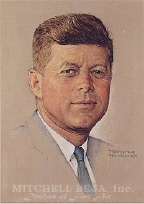 | KENNEDY AND
VIETNAM
The Kennedy
administration, which entered the White House in 1961, also supported President Diem. However.
Kennedy was wary of accusations that Democrats were "soft" on
communism. In fact,
Kennedy, a catholic, was a strong anti-communist. Therefore, he increased financial aid to
Diem's regime and sent thousands of military advisers to help train South Vietnamese
troops in their battle against the NLF (National Liberation Front). By the end of 1963, almost 16,000
U.S. military personnel were in South Vietnam.
Meanwhile, Diem's popularity plummeted
because of social unrest and lack of land reform. To combat the growing Vietcong
| presence in the South's countryside, the Diem
administration initiated the strategic hamlet program, which meant moving all villagers to
protected areas. Many Vietnamese deeply resented being moved from their home villages where they had
lived for generations and where ancestors were buried.
Diem also intensified his attack on the
Buddhist monks. Fed up with continuing Buddhist demonstrations, the South Vietnamese ruler imprisoned
hundreds of Buddhist clerics and destroyed their temples. To protest, several Buddhist monks and nuns
publicly burned themselves to death. Horrified, American officials urged Diem to stop the
persecutions, but Diem refused.
It had become clear that for South Vietnam to remain stable,
Diem would have to go. On November 1, 1963, a U.S.-supported military coup toppled Diem's
regime. Diem and his family were murdered. A few weeks later, Kennedy too fell to an assassin's
bullet. The presidency-along with the growing crisis in Vietnam-now belonged to Lyndon B.
Johnson.
| | |
|
|
|
72.
|
By 1963, which American
president had put the most U.S. forces in Vietnam and made the biggest commitment against communism
there?
a. | Truman | c. | Kennedy | b. | Eisenhower | d. | Johnson |
|
|
|
73.
|
President Diem attacked the
Buddhist demonstrators, started a program called the strategic hamlet program and worked to preserve
the land for its owners. All of these actions made Diem _____ in Vietnam.
a. | unpopular | c. | valued | b. | popular | d. | honored |
|
|
|
74.
|
What president inherited the
Vietnam war from John F.Kennedy?
a. | Dwight
Eisenhower | c. | Lyndon
Johnson | b. | Harry Truman | d. | Barry Goldwater |
|
|
|
| President Johnson Expands the Conflict
Some people claim that shortly before his death,
Kennedy had announced his intent to withdraw U.S. forces from South Vietnam. "In the final
analysis, it's their war," he declared. Whether Kennedy would have, in fact, withdrawn from
Vietnam remains a matter of debate. His actions show otherwise and his history shows that he was an
anti-communist and committed to South Vietnam. Lyndon Johnson continued the Kennedy policies and
escalated-or increased-the nation's role in Vietnam. Johnson kept most of the Kennedy
advisors so there was a continuation of the Kennedy policies in the Johnson
administration. | The South Grows More
Unstable
Diem's death brought more chaos to South Vietnam. A string of military leaders
attempted to lead the country, but each regime was more unstable and inefficient than Diem's had
been. Meanwhile, the Vietcong's influence in the countryside steadily grew.To President
Johnson, a Communist takeover of South Vietnam would be disastrous. As a Democratic president, Lyndon
Johnson was particularly sensitive to being perceived as "soft" on communism. A Democrat,
Harry Truman, had been president when China fell to the Communist Party in 1948, unleashing charges
by some Republicans that the Democrats had "lost" China. In addition, many of Senator
Joseph McCarthy's charges during the 1950s of Communist infiltrators in America had been
directed against Democrats. For these political reasons, Johnson wanted to avoid being accused of
"losing" Vietnam. "If I ... let the Communists take over South Vietnam," Johnson
said, "then ... my nation would be seen as an appeaser, and we would find it impossible to
accomplish anything ... anywhere on the entire globe." | | |
|
|
|
75.
|
The government that came after
the Diem government was
a. | better than the Diem
government | c. | worse than the
Diem government | b. | the same as the Diem government | d. | a little bit better than the Diem
government |
|
|
|
76.
|
After the Diem was assassinated
the influence of the Vietcong in South Vietnam
a. | decreased | c. | stayed the same | b. | was eliminated | d. | increased |
|
|
|
77.
|
America was an anti-communist
country and so were her presidents. Both Kennedy and Johnson were afraid of being called _____
communism by the American public. They were both Democrats and their party had that
reputation.
a. | soft on | c. | resentful to | b. | hard on | d. | unreasonable to |
|
|
|
THE TONKIN GULF RESOLUTION
On August 2, 1964, a North
Vietnamese patrol boat fired a torpedo at an American destroyer, the U.S.S. Maddox, which was
patrolling in the Gulf of Tonkin off the North Vietnamese coast. The torpedo missed its target, but
the Maddox inflicted heavy damage on the patrol boat.
Two days later, the Maddox and another
destroyer were again off the North Vietnamese coast. In spite of bad weather, technicians reported
enemy torpedoes. The American destroyers began firing. The attack on the U.S. ships prompted Johnson
to launch bombing strikes on North Vietnam. He also asked Congress for powers to take "all
necessary measures to repel any armed attack against the forces of the United States and to prevent
further aggression." Congress overwhelmingly approved Johnson's request, with only two
senators voting against it. On August 7, Congress adopted the Tonkin Gulf Resolution. While
not a declaration of war, it granted Johnson broad military powers in Vietnam.
Johnson did not
tell Congress or the American people that the United States had been leading secret raids against
North Vietnam. The Maddox had been in the Gulf of Tonkin to collect information for these raids.
Furthermore, Johnson and his advisors from the Kennedy administration had prepared the resolution
months beforehand and was only waiting for the chance to push it through Congress.
In February
of 1965, President Johnson used his newly granted powers. In response to a Vietcong attack that
killed eight Americans, Johnson unleashed Operation Rolling Thunder, the first sustained
bombing of North Vietnam. In March of that year the first American combat troops began arriving in
South Vietnam. By June, more than 50,000 U.S. soldiers were battling the Vietcong. The Vietnam War
had become Americanized.
| |
|
|
|
78.
|
What prompted President Johnson
to bomb North Vietnam?
a. | Attacks on navy ships by North
Vietnam | c. | Attacks on navy
ships by South Vietnam | b. | Attacks on North Vietnam boats | d. | Vietcong attacks on navy ships |
|
|
|
79.
|
The U.S. Constitution says that
only the U.S. Congress can declare war. Where then did President Johnson get the Power to fight the
war in Vietnam?
a. | The Washington
Resolution | c. | Gulf of Tonkin
Resolution | b. | The North Vietnam Accords | d. | Vienna Accords |
|
|
|
80.
|
Kennedy and Johnson are to
communism as George Bush is to ...
a. | socialism | c. | Vietnam | b. | Iraq | d. | terrorism |
|
|
|
81.
|
It can safely be said that
Presidents Truman, Eisenhower, Kennedy, Johnson, and Nixon after him, all agree that Vietnam was part
of a world-wide struggle against communism and for freedom in the world.
|
|
|
Much of the nation
supported Lyndon Johnson's determination to contain communism in Vietnam . Therefore, President
Johnson began sending large numbers of American troops to fight alongside the South Vietnamese Army
against the forces of the Vietcong and the North Vietnamese Army. Johnson did not want to send more
troops to Vietnam but his Generals believed the South Vietnam army could not win alone. Working
closely with his foreign-policy advisers, particularly Secretary of Defense Robert McNamara and
Secretary of State Dean Rusk, President Johnson began dispatching tens of thousands of U.S.
soldiers to fight in Vietnam.
A 1965 poll showed that 61 percent of Americans supported the U.S .
policy in Vietnam, while only 24 percent opposed it. There were dissenters in the Johnson
administration. In October of 1964, Undersecretary of State George Ball argued against
escalation. Remember, Johnson kept Kennedy’s advisors and continued his policies on
Vietnam. They had a strong influence on Johnson so he sent more
troops.
|
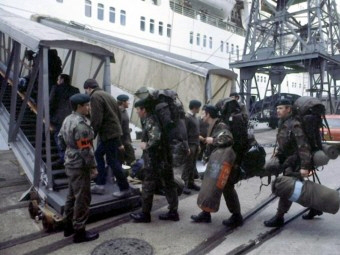
The American commander in South Vietnam, General William Westmoreland said he wanted more
troops. By 1967, the number of U.S .
troops in Vietnam had climbed to about
500,000. | | |
|
|
|
82.
|
Johnson felt that the South
Vietnam army was not able to fight the war against the North without help. What did Johnson
do?
a. | Sent more military aid to the
South | c. | Asked the Chinese in Taiwan to
help | b. | Discussed ways to get out of Vietnam | d. | Send more American troops |
|
|
|
83.
|
What percentage of the American
people supported the war in 1965?
a. | 50 | c. | 76 | b. | 61 | d. | most people were against the war |
|
|
|
84.
|
One of the strongest Johnson
advisors who supported the war was Secretary of Defense _____
a. | George
Ball | c. | Dean
Rusk | b. | Robert McNamara | d. | George McBundy |
|
|
|
85.
|
Who was General of U.S. forces
in Vietnam?
a. | General George
Ball | c. | Secretary of Defense Robert
McNamara | b. | General William Westrmorland | d. | Secretary of State Dean Rusk |
|
|
|
The
Vietcong
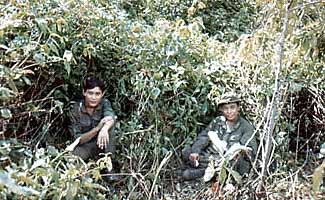
Vietcong |

Ho Chi Minh
North Vietnam Leader
Supported
the Vietcong in the South | The United
States entered the war in Vietnam believing that its superior weaponry would lead it to victory over
the Vietcong. However, the jungle terrain and the enemy's guerrilla tactics soon turned the war
into a frustrating stalemate. Because the Vietcong lacked the high-powered weaponry of the American
forces, they used hit-and-run and ambush tactics, as well as a keen knowledge of the jungle terrain,
to their advantage. Moving secretly in and out of the general population, the Vietcong destroyed the
notion of a frontline by attacking U.S . troops in both the cities and the countryside . Because some
of the enemy lived amidst the civilian population, it became increasingly difficult for U .S. troops
to discern friend from foe . A woman selling soft drinks to U .S. soldiers might be a Vietcong spy. A
boy standing on the corner might be ready to throw a grenade. In addition, the enemy laced the
terrain with countless booby traps and land mines . American soldiers marching through South
Vietnam's jungles and rice paddies dealt not only with sweltering heat and leeches but also with
deadly traps. The Vietcong also had an elaborate system of tunnels throughout
Vietnam.
General
Westmorland introduced the concept of the body count, or the tracking of Vietcong killed in
battle, the general believed that as the number of Vietcong dead rose, the enemy's surrender
would become inevitable . However, the Vietcong had no intention of quitting their fight. What Ho
Chi Minh had told the French in the 1940s applied also to the Americans, "You can kill ten
of my men for every one I kill of yours," he warned, "but even at those odds, you will lose
and I will win ."
The campaign to win the "hearts and minds" of the South
Vietnamese villagers proved more difficult than the Americans imagined. Some of the tactics the
Americans used to battle the Vietcong also harmed much of the rural population. For instance, in
their attempt to expose Vietcong tunnels and hideouts, the U.S . planes dropped napalm, a
gasoline-based bomb that set fire to the jungle. American planes also sprayed Agent Orange, a
leaf-killing toxic chemical that devastated the landscape. The saturation use of these weapons often
wounded villagers and left villages and their surrounding area in
ruins.
| | |
|
|
|
86.
|
Who had the superior weapons in
Vietnam?
a. | the
Americans | c. | the
Vietminh | b. | the Vietcong | d. | the North Vietnamese |
|
|
|
87.
|
It can be said that Americans
were
a. | happy about their success in winning
over the civilian population in South Vietnam | c. | frustrated about their inability to win over the
villagers | b. | unconcerned about winning over the civilian
population | d. | able to win over the civilian
population |
|
|
|
88.
|
Judging by the comments of
their leaders, who had the greatest concern for human life?
a. | the
Vietcong | c. | the South
Vietnamese | b. | the North Vietnamese | d. | the Americans |
|
|
|
Sinking Morale
In the beginning the morale of the American troops was high. Also many of the
troops were volunteers and many came from middle and upper middle class home. As the war continued,
American morale dropped steadily. as some soldiers turned to alcohol, marijuana, and other drugs. The
new people coming into the army reflected the new American culture with its emphasis on drugs. The
late 1960’s was the start of the “hippie” generation. Morale would worsen during
the later years of the war when soldiers realized they were fighting even as their government was
negotiating for peace.
Despite the low morale among some U.S. troops, most soldiers firmly
believed in their cause-to halt the spread of communism. They took patriotic pride in fulfilling
their duty, just as their fathers had done in World War II.
Many American soldiers fought courageously. Particularly
heroic were the thousands of soldiers who endured years of torture and confinement as prisoners of
war.Their torture was made worse by the anti-war protests at home.
|
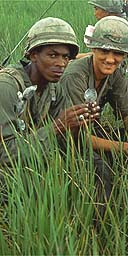
Soldiers using drugs in
Vietnam | | |
|
|
|
89.
|
Which statement below is true
about American soldiers in Vietnam?
a. | later in the war some took
drugs | c. | later in the war none took
drugs | b. | later in the war all took drugs | d. | most took drugs all through the
war |
|
|
|
90.
|
Which statement below is true
about solders in Vietnam?
a. | The use of drugs by some soldiers
reflected their frustration with the war | d. | all of these statements are true | b. | Not all soldiers used drugs, most were conscientious and
dedicated fighters | e. | none of these statements are
true | c. | The soldiers in Vietnam were kids who reflected the culture they cam
from |
|
|
|
91.
|
What effect did the anti-war
protests have on the American prisoners of war in Vietnam?
a. | made imprisonment a little
better | c. | had no effect on
imprisonment | b. | made imprisonment a-lot worse | d. | the Vietnamese had no knowledge of the anti-war protests in
America |
|
|
|
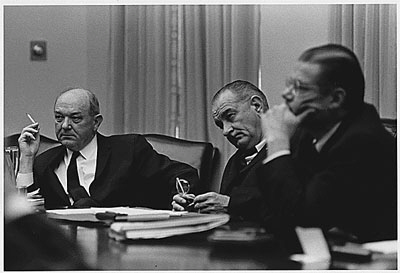
Secretary of
State Dean Rusk - President Johnson - Secretary of Defense Robert
McManara |
THE GREAT SOCIETY SUFFERS
When
President Johnson took office from Kennedy, he wanted to put in place many new domestic programs
called, “The Great Society.” Medicare was one of those domestic programs. As the number
of U.S. troops in Vietnam continued to mount, the war grew more costly. As a result, the
nation's economy began to suffer. The inflation rate, which had remained at 2 percent through
most of the early 1960s, nearly tripled by 1969. President Johnson had been determined to pay for
both the war and his Great Society programs. Inflation means there is a rise in prices.
However, the cost of financing the Vietnam War became too great. In August of 1967, Johnson
asked for a tax increase to help fund the war and to keep inflation in check. Congressional
conservatives agreed, but only after demanding and receiving a $6 billion reduction in funding for
Great Society programs. Vietnam was slowly claiming an early casualty: Johnson's grand vision of
domestic reform.
| |
|
|
|
92.
|
The “Great Society”
was a
a. | military
program | c. | domestic
program | b. | Vietnam war program | d. | financial program |
|
|
|
93.
|
We can infer from the reading
that _____ might be part of the President Johnson’s “Great Society”
a. | aid to
education | c. | military pay
raises to boost morale | b. | scientific research into new weapons | d. | political fund raising |
|
|
|
94.
|
The opposite of a conservative
is a liberal. Therefore we can infer from the reading that President Johnson must have been a _____
on domestic issues.
a. | conservative | c. | a hawk | b. | socialist | d. | liberal |
|
|
|
95.
|
Put these wars in the correct
order according to the presidents who administered them
World War I - World War II - Vietnam -
Iraq
a. | Roosevelt - Wilson - Johnson -
Bush | c. | Wilson - Roosevelt - Johnson -
Bush | b. | Roosevelt - Johnson - Wilson - Bush | d. | Johnson - Wilson - Bush -
Roosevelt |
|
|
|
96.
|
If the inflation rate rises as
it did in the Vietnam war, the same amount of money will buy _____
a. | more | c. | the same | b. | less | d. | inflation has no effect on the value of
money |
|
|
|
The Living Room
War
By 1967, a majority of Americans still
supported the war. However, cracks were beginning to show. The media, mainly television, helped
heighten the nation's growing concern about the war. Vietnam was America's first
"living-room war," in which footage of combat appeared nightly on the news in millions of
homes. And what people saw on their television screens seemed to contradict the optimistic war
scenario that the Johnson administration was painting.
Quoting body-count statistics that
showed large numbers of Communists dying in battle, General Westmoreland continually reported that a Vietcong surrender was
imminent. Victory "lies within our grasp-the enemy's hopes are bankrupt," he declared.
Defense Secretary McNamara backed up the general's rosy analyses. saying that he could
see "the light at the end of the tunnel." | 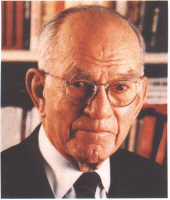 Senator William
Fulbright Senator William
Fulbright
Critic of the Johnson Vietnam policy |
However, the repeated television images of Americans in body bags told a
different story. Communists may have been dying, but so too were Americans nearly 16,000 between 1965
and 1967. Critics charged that a credibility gap was growing between what the Johnson administration
reported and what was really happening.
One such critic was Senator J. William Fulbright, chairman of the
powerful Senate Foreign Relations Committee. Fulbright, a former Johnson ally, charged the president
with a "lack of candor" in portraying the war effort. In early 1966, the senator conducted
a series of televised committee hearings to investigate the Johson war policies.
It was in
1967 that the war protest movement on college campuses grew and began to be
noticed. | | |
|
|
|
97.
|
Secretary of Defense, Robert
McNamara said, “We see light at the end of the tunnel” What did he
mean?
a. | there is no end insight for the
war | c. | the Vietcong are being driven out of
their tunnels | b. | the war will be over soon | d. | critics of the war have “tunnel
vision” |
|
|
|
98.
|
Why was the Vietnam war called,
“the living room war?”
a. | people could see the war every night
on television | c. | America needed
living room and that is one of the reasons we went to war | b. | most Americans were untouched by the way and went about
their lives normally | d. | most soldiers preferred their living
rooms at home to the Vietnam jungles |
|
|
|
99.
|
The difference between what
Americans were told by the Johnson administration and what they saw on television every night was
called
a. | light at the end of the
tunnel | c. | body
count | b. | Johnsons folly | d. | the credibility gap |
|
|
|
100.
|
The Chairman of the Senate
Armed Services Committee, was William Fullbright. How did he feel about the war?
a. | he was
unconcerned | c. | he was suspicious
and critical | b. | he ignored it | d. | he was supportive |
|
|
|
101.
|
Which media was responsible for
raising the American publics concern over the Vietnam war?
a. | television | c. | General Westmorland | b. | the Department of
Defense | d. | the college campus
protests |
|
|
|
A Working-Class War
The idea of fighting a
war in a faraway place for what some believed was a questionable cause prompted a number of young
Americans to avoid going to Vietnam. Because many middle-class and upper-class American youths were
able-through college and other means-to avoid military service, most of the soldiers who fought in
Vietnam were from the lower economic classes of American society.
A “MANIPULATABLE”
DRAFT Most soldiers who fought in Vietnam were drafted into combat under the country’s
Selective Service System. Under this system, which had been established in the 1940s during World War
II, all males had to register with their local draft boards when they turned 18. In the event of a
war, the board called men between the ages of 18 and 26 into military service as they were needed .
Thousands of men attempted to find ways around the draft. Because many medical excuses were honored,
some men sought out sympathetic doctors to obtain medical deferments . Local draft boards decided who
would be drafted. Different draft boards had different qualifications, which prompted some men to
change residences in order to stand before more lenient boards. Some Americans even joined the
National Guard or Coast Guard, which often secured a deferment from service in Vietnam. One of
the most common ways to avoid the draft was to receive a college deferment, by which a young man
enrolled in a university could put off his military service. Because most university students during
the 1960s were white and some were financially well-off, many of the men who fought in Vietnam were
lower-class whites or |

minorities who were
less privileged economically. To be sure, the majority of Americans who were drafted proudly went to
Vietnam .
Others volunteered to fight, their reasons ranging from a sense of duty to a feeling of
patriotism. Nonetheless, with almost 80 percent of American soldiers coming from lower economic
levels, Vietnam was a working-class war
| | |
|
|
|
102.
|
Almost 80 percent of soldiers
who fought in Vietnam were _____ .
a. | middle class college
students | c. | from the
South | b. | from non-college lower economic levels | d. | from the Northeast |
|
|
|
103.
|
Americans were drafted into
wars as far back as the American Revolution. The present system for drafting soldiers was called the
“Selective Service System.” It was made-up of local people who tried to be fair and
decided who would be drafted and who would not. When was the Selective Service System
established.?
a. | World War
I | c. | Civil
War | b. | World War II | d. | 1920’s |
|
|
|
104.
|
To get out of the draft because
you were in college was one of the main ways to escape service. This method was called a college
_____
a. | probation | c. | deferment | b. | annulment | d. | extension |
|
|
|
Women and Minorities in the War
While there was some racial tension in the military
during the Vietnam war, there was much less tension than there was in the civilian sector. The civil
rights movement was in full swing in the United States and that led to some of the tension. Dr.
Martin Luther King did not agree with the war and he spoke out against it. Finally, there was some
natural resentment of soldiers who looked at the thousands of college students who did not have to be
called to duty. There was a high percentage of black soldiers who were killed but that was because of
their economic status rather than any conscious effort to put black soldiers in harms way. Most black
soldiers were loyal and heroic. Some found themselves in positions of leadership for the first time
in their lives during the war. Colin Powell fought in Vietnam,
While the U .S . military in the 1960s did not allow
females to serve in combat, nearly 7,500 women served in Vietnam as army and navy nurses. Thousands
more women volunteered their services in Vietnam to the American Red Cross and the United Services
Organization (USO), which delivered hospitality and entertainment to the
troops.
|
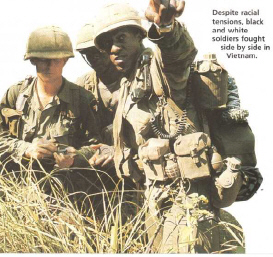 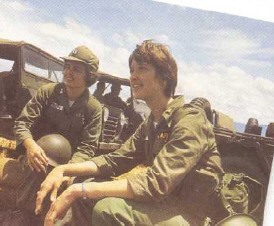 | | |
|
|
|
105.
|
There was a conscious effort to
push black soldiers onto the front lines during the Vietnam war.
|
|
|
106.
|
The civil rights movement in
the U.S. took place _____ the war in Vietnam.
a. | before | c. | after | b. | because of | d. | during |
|
|
|
107.
|
Women in Vietnam served in
_____ positions.
a. | combat | c. | leadership | b. | non-combat | d. | fighting |
|
|
|
108.
|
Dr. Martin Luther King spoke
out _____ the war in Vietnam.
a. | against | c. | in favor of | b. | in silence for | d. | quietly in favor of |
|
|
|
Anti War Movement Emerges
In the years prior to America’s involvement in Vietnam, an atmosphere of
protest already existed in many college campuses. In contrast to the general contentment that
characterized the youths of the 1950s, students in the early 1960s had become more active socially
and politically . Some had participated in the civil rights struggle, while others had answered
President Kennedy’s call to more actively pursue public service . By the mid-sixties, many
youths believed! the nation to be in need of fundamental change.
THE NEW LEFT The
growing youth movement of the 1960s became known as the New Left, which encompassed many different
activist groups and organizations . The movement was “new” in relation to the “old
left” of the 1930s, which generally tried to move the nation toward socialism, and, in some
cases, communism . While the New Left movement did not preach socialism, its followers demanded
sweeping changes in American society.
Voicing these demands was one of the better-known New Left organizations,
Students for a Democratic Society (SDS) . Tom Hayden and Al Haber, two University of Michigan
students, founded the group in 1959. Three years later, they convened a meeting in Port Huron,
Michigan, to draft the group’s declaration. Known as the Port Huron Statement, it began :
“We are people of this generation, bred in at least modest comfort, housed now in universities,
looking uncomfortably to the world we inherit.” The statement, which charged that corporations
and large government institutions had taken over America, called for a restoration of
“participatory democracy” and greater individual freedom.
In 1964, another
New Left group gained prominence . At the University of California at Berkeley, the Free Speech
Movement (FSM) grew out of a clash between students and administrators over free speech on campus.
Led by Mario Savio, a philosophy major and a dynamic speaker, the FSM soon focused its criticism on
what it called the American “machine,” the nation’s faceless and powerful business
and government institutions .
CAMPUS ACTIVISM
The strategies and tactics of the FSM
and SDS soon spread to colleges throughout the country. There, students addressed mostly campus
issues, such as dress codes, curfews, dormitory regulations, and mandatory Reserved Officer Training
Corps (ROTC) programs . At Fairleigh Dickinson University in New Jersey, students marched merely as
“an expression of general student discontent With the onset of the Vietnam War, the students
suddenly found a galvanizing issue . At campuses across the country, American youths joined together
to protest the war. |
"It isn't the
rebels who cause the troubles of the world, it's the troubles that cause the
rebels.".. Carl Oglesby,
SDS
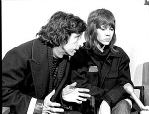
Tom Hayden and Jane Fonda
What
motivated these young people to protest?. Was it idealism, was it a desire to avoid the draft or was
it a way to be “cool?”. Maybe a little of each. To be in favor of the war and in college
in the 60’s and 70’s was to be alienated from your classmates and many of your college
professors. The anti-war groups had the drugs, the music and the girls. Beards, beads and sandals
were “in.” | | |
|
|
|
109.
|
Comparing the 1950’s to
the 1960’s, which statement below is not true
a. | 60’s youth were more
intelligent | c. | 60’s youth
were more concerned about social issues | b. | 60’s youth were more liberated | d. | 60’s youth were more aware of
politics |
|
|
|
110.
|
The SDS and other activist
groups of the 1960’s became known as
a. | the old
left | c. | the Socialist
left | b. | the new left | d. | the new right |
|
|
|
111.
|
SDS stood for
....
a. | Soviet Demonstration
Society | c. | Students for
Democratic Society | b. | Saving Democracy Society | d. | Students for Demonstration
Societies |
|
|
|
112.
|
The new left was
anti
a. | business | c. | traditions | b. | war | d. | all of
these |
|
|
|
THE MOVEMENT GROWS
Throughout
the spring of 1965, a number of colleges began to host “teach-ins”
to protest the war. At the University of Michigan, where only a year before, President Johnson had
announced his sweeping Great Society program, teachers and students now assailed his war policy.
“This is no longer a casual form of campus spring fever,” journalist James Reston noted
about the growing demonstrations . As the war continued, the protests grew and divided the country
between those Americans who supported their government’s policy in Vietnam and those who
opposed it.
In April of 1965,
SDS helped organize a march on
Washington, D .C., by some 20,000 protesters . By November of that year, a
protest rally in Washington drew more than 30,000. Then, in January of 1966, the Johnson administration changed
deferments for college students . Students now had to be in good academic standing to defer their
military service . Campuses around the country erupted in protest. SDS called for civil disobedience
at Selective Service Centers and openly counseled students to flee to Canada or Sweden . By the end
of 1967, SDS had chapters on
nearly 300 campuses. The protesters claimed that the conflict in Vietnam was basically a civil
war and that the U.S. military had no busi ness there. Others argued that the United States could not
police the world. Still others saw the war simply as morally unjust.
As the antiwar
movement grew, it reached outside the college campuses and touched other groups in society. Small
numbers of returning veterans also began to protest the war. Some antiwar veterans returned their
medals to President Johnson. In addition, many musicians took up the antiwar cause. Folk singers such
as Peter, Paul and Mary and Joan Baez led the way as music became a popular protest vehicle . Soon
protest songs even conquered the pop-music charts. Number one in September 1965 was “Eve of Destruction,”
in which singer Barry McGuire stressed the ironic fact that in the 1960s an
American male could be drafted at 18 but had to be 21 to vote : | |
|
|
|
113.
|
By 1968 the U.S. was divided
between _____
a. | business and
labor | c. | pro Vietnam war and anti Vietnam
war | b. | Great Society and those against | d. | soldiers and civilians |
|
|
|
114.
|
In 1966 the Johnson
administration ruled that students needed to be a student in good academic standing at a college in
order to have a deferment. What was the result of this ruling?
a. | Some students fled to
Canada | c. | Campuses erupted into
protest | b. | Demonstrations at Selective Service Offices | d. | All of these |
|
|
|
115.
|
Every paragraph has a topic
sentence. It is the main idea of the paragraph. The rest of the sentences are supporting details that
support the main idea. What is the topic sentence of the last paragraph above?
a. | Some antiwar veterans returned their
medals to President Johnson | c. | Soon protest songs even conquered the pop-music
charts | b. | As the antiwar movement grew, it reached outside the college campuses and touched other
groups in society | d. | In addition, many musicians took up
the antiwar cause |
|
|
|
FROM PROTEST TO RESISTANCE
From 1965 to 1967, the antiwar
movement intensified. “We were having no effect on U.S . policy,” recalled one protest
leader. “So we thought we had to up the ante.” In the spring of 1967, nearly half a
million protesters of all ages gathered in New York’s Central Park. Shouting “Burn
cards, not people” and “Hell, no, we won’t go!” hundreds tossed their draft
cards into a bonfire . Many in the park were protesting for the first time. A housewife from New
Jersey told a reporter, “So many of us are frustrated. We want to criticize this war
because we think it’s wrong, but we want to do it in the framework of
loyalty.”
Draft resistance
continued from 1967 until President Nixon phased out the draft in the early 1970s During these years,
the U.S. government accused more than 200,000 men of draft offenses and imprisoned nearly 4,000 draft
resisters. (Most won parole after 6 to 12 months behind bars, while some served four or five
years.) Throughout these years, about 10,000 Americans fled to Canada rather than serve in the
military.
Responding to antiwar posters, Americans who supported the government's Vietnam
policy developed their own slogans : "Support our men in Vietnam" and "America-love it
or leave it." In one incident construction workers came down from the buildings they were
working on and beat protestors in an anti-Vietnam parade when the protestors defaced the American
flag. Because they wore construction hard hats, the term, “hard-hat,” now has come to
mean anyone who is a conservative patriotic middle class working
person.
| |
|
|
|
116.
|
The passage above shows clearly
that Americans were _____ over the war in Vietnam.
a. | polarized | c. | unconcerned | b. | united | d. | enthused |
|
|
|
117.
|
What president ended the draft
in 1970?
a. | Johnson | c. | Carter | b. | Nixon | d. | Reagan |
|
|
|
WAR DIVIDES THE NATION
By 1967, Americans increasingly found themselves divided into two camps
regarding the war. Those who strongly opposed the war and believed the United States should
withdraw were known as doves. Feeling just as strongly that America should unleash a greater show of
military force to end the war were the hawks.
Despite the visibility of the antiwar protesters, a
majority of American citizens in 1967 still remained committed to the war. In May of that year,
a prowar march through the streets of Manhattan drew 20,000 people . During this time, a poll showed
that two-thirds of Americans still felt that the war was justified. And while only 10 percent of
Americans approved of’ the administration’s present level of commitment in Vietnam, about
50 percent felt that “increased attacks” against North Vietnam would help win the war. A
poll taken in December of 1967 showed that 70 percent of Americans believed the war protests were
“acts of disloyalty.”
JOHNSON REMAINS DETERMINED
Throughout the turmoil and division that engulfed the
country during the early years of the war, President Johnson remained firm. Attacked by doves for not
withdrawing and by hawks for not increasing military power rapidly enough, Johnson continued his
policy of slow escalation . As for the protesters who paraded outside his window, the president saw
them as misguided and misinformed. They “wouldn’t know a Communist if they tripped over
one,” he declared.
However, by the end of 1967, Johnson’s policy-and the
continuing stalemate-had begun to create turmoil within his own administration . In November, Defense
Secretary McNamara, a key architect of U.S. escalation in Vietnam, quietly announced he was resigning
to become head of the World Bank.
As it happened, McNamara’s resignation came on the
threshold of the most tumultuous year of the sixties. In 1968 the war-and Johnson’s presidency
would take a drastic turn for the worse . | |
|
|
|
118.
|
People who were against the war
in Vietnam were called _____ and those in favor of the war were called _____
a. | hawks -
doves | c. | doves -
hawks | b. | pigeons - eagles | d. | fish - sharks |
|
|
|
119.
|
In 1967 _____ of
the people in the U.S. supported the war.
a. | a
majority | c. | only a
minority | b. | only a slight majority | d. | half |
|
|
|
120.
|
This person was a holdover from
the Kennedy administrtion and was the main architect of the Vietnam war. After guiding President
Johnson into the war he resigned in 1967. Who was he?
a. | Robert
McNamara | c. | Maxwell
Clark | b. | Bobby Kennedy | d. | Jerry Rubins |
|
|
|
121.
|
Which group wanted to increase
the war effort to finally win the war in Vietnam?
a. | SDS | c. | FSM | b. | hawks | d. | American Eagles |
|
|
|
The year 1968 began with a daring surprise
attack by the Vietcong on numerous cities in South Vietnam. The simultaneous strikes, while a
military defeat for the Communist guerrillas, stunned the American public and caused many people with
moderate views to begin turning against the war.
A SURPRISE ATTACK
January 30 was the Vietnamese New Year’s
Eve. The lunar new year festivities were called Tet. Throughout that day in 1968, villagers streamed
into cities across South Vietnam to celebrate their New Year. At the time of the Tet celebration,
many funerals were being held for victims of the war. As it turned out, the coffins contained
weapons, and many of the villagers were Vietcong agents . That night the enemy launched an attack on
nearly 100 towns and cities in South Vietnam, as well as 12 U.S . air bases . The fighting was
especially fierce in Saigon and in the former imperial capital of Hue. The Vietcong even attacked the
U.S. embassy in Saigon, killing five Americans there. The Tet offensive continued for nearly a month
before U.S . and South Vietnamese forces regained control of the cities General Westmoreland
declared the attacks an overwhelming defeat for the Vietcong. From a purely military standpoint,
Westmoreland was right. The Vietcong lost about 32,000 soldiers during the month-long battle, while
the American and ARVN (South Vietnam) forces lost little more than 3,000.
However, from a psychological-and political-standpoint,
the Vietcong made gains. Despite its overall military failure, the Tet offensive greatly shook an
American public that had come to believe that the enemy was close to defeat. The Johnson
administration’s credibility gap suddenly widened to a point from which it would never recover.
|
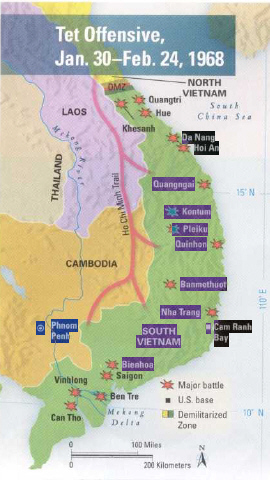
Many Americans no
longer believed the administration. Part of the problem for the U.S. was the way the Tet Offensive
was reported in the American media. People who opposed the war, many in the media, used Tet to prove
that the U.S. was loosing the war. In fact, the U.S. was winning the war but the perception was that
the U.S. was loosing. In the political world, perception is everything and the perception was that
President Johnson was defeated by the Vietnam war.
| | |
|
|
|
122.
|
What was
Tet
a. | Summer holiday for the
Vietnamese | c. | The holiday equal
to our Christmas | b. | Vietnamese New Year | d. | Election Day in Vietnam |
|
|
|
123.
|
The Tet offensive was a
military defeat for
a. | the
U.S. | c. | neither the U.S. nor the
Vietnamese | b. | the Communists Vietnamese | d. | both the Communists and the U.S. |
|
|
|
124.
|
The Tet offensive was a
psychological defeat for
a. | the
U.S. | c. | neither the U.S. or the
communists | b. | the Communist Vietnamese | d. | both the U.S. and the communists |
|
|
|
125.
|
Look at the map. The Ho Chi Min
Trail was a series of trails that the North Vietnamese used to supply the Vietcong and the North
Vietnam soldiers in the South. What countries did the Ho Chi Minh trail go
through?
a. | Laos, Cambodia,
Vietnam | c. | Cambodia,
Thailand, China | b. | Laos, Cambodia, Thailand | d. | North Vietnam, Thailand, |
|
|
|
A NATION TURNS ON
JOHNSON
The main-stream
media, which had reported the war in a skeptical but generally balanced way, now openly criticized
the war.One of the nation’s most respected journalists, Walter Cronkite, told his viewers that
it now seemed “more certain than ever that the bloody experience of Vietnam is to end in a
stalemate.” In a matter of weeks, the Tet offensive had changed millions of minds about the
war. Minds were also changing at the White House. To fill the defense secretary position left
vacant by Robert McNamara’s resignation, Johnson picked Clark Clifford, a trusted friend and
strong supporter of the president’s Vietnam pol icy. However, after settling in and studying
the situation, Clifford concluded that the war was unwinnable. “We seem to have a
sinkhole,” Clifford said . “We put in more-they match it . I see more and more fighting
with more and more casualties on the U.S . side and no end in sight to the action.
In the weeks
following the Tet offensive, Johnson’s popularity plummeted. In public opinion polls taken at
the end of February 1968, nearly 60 percent of the American public disapproved of the
president’s handling of the war. Nearly half of the country now felt it had been a mistake to
send American troops to Vietnam. Johnson recognized the change, too. Upon learning of
Cronkite’s pessimistic analysis of the war, the president lamented, “If I’ve lost
Walter, then its over. I’ve lost Mr.Average Citizen” | |
|
|
|
126.
|
Who was Walter
Cronkite?
a. | A popular
Senator | c. | A popular nightly
news broadcaster | b. | A popular Talk Radio Host | d. | The host of the Tonight Show |
|
|
|
127.
|
President Johnson relied
heavily on advice from former Kennedy advisors about the war in Vietnam. Events showed that the
advise he got was
a. | good | c. | pro communist | b. | helpful | d. | faulty |
|
|
|
128.
|
What does this passage suggest
about the American Presidency?
a. | The president has the ultimate
responsibility for foreign policy in the U.S. | c. | The president is not responsible for the war because he used Kennedy’s
advisors. | b. | Congress is responsible for foreign affairs | d. | The Supreme Court should have helped Johnson with the Vietnam
war |
|
|
|
JOHNSON WITHDRAWS
Well before the Tet offensive, an antiwar coalition within the Democratic
Party had taken steps to unseat President Johnson . The group sought a Democratic candidate to
challenge Johnson in the 1968 presidential primary election. Senator Gene McCarthy, a strong critic of the
war, and declared he would run against Johnson. McCarthy was a Democrat and it was unusual for a
Democrat to run against his own President. Robert Kennedy promised McCarthy that he would not run for
President but said he would support McCarthy. In fact no one thought McCarthy had a chance of beating
Johnson.
In the New Hampshire Democratic primary in March 1968, Senator McCarthy shocked the
nation by capturing 42 percent
of the vote. While Johnson won the primary with 48
percent of the vote, the slim margin
of victory was viewed as a defeat for the president. Johnson seemed weak in the polls so Kennedy went
back on his promise to McCarthy and announced that he too was running for president against Johnson.
It is a well known fact that Johnson and Kennedy had a deep dislike for each other going back as
far as 1960. Johnson felt that the Kennedy’s looked down on him because he was not born rich
and went to a small, unknown college. Many people believed that Johnson could not bear to loose the
presidential election to Bobby Kennedy. This fact may have contributed to the following
event. | 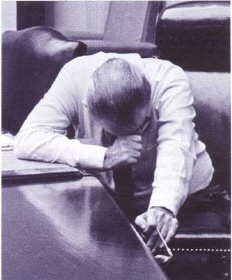
President Johnson
decided not to run for President again
On March 31, 1968, President Johnson made a speech to the nation on Vietnam.
He ended the speech by saying, Accordingly, I shall not seek, and I will not accept, the nomination
of my party for another term as president.” The president was stepping down from national
politics, his grand plan for domestic reform done in by a costly and divisive war. Johnson admitted
that the Vietnam war had killed his “Great Society plans.“ | | |
|
|
|
129.
|
Why did Johnson fear he would
not be able to beat Robert Kennedy in an election for President?
a. | Kennedy had more
money | c. | Johnson was low in the polls and
unpopular at the time | b. | Kennedy was better looking | d. | Kennedy, like Johnson was in favor of the
war. |
|
|
|
130.
|
If McCarthy got 42% of the vote
in New Hampshire, and Johnson got 48% of the vote, why was it considered a defeat for
Johnson?
a. | McCarthy was a
Republican | c. | Neither candidate
got a majority | b. | To be president you need 268 electoral votes | d. | No one expected McCarthy to do that well against a sitting
president |
|
|
|
131.
|
What was the “grand plan
for national reform” that Johnson believed he was unable to complete because of the Vietnam
war?
a. | The New
Deal | c. | Vietnamization | b. | The Square Deal | d. | The Great Society |
|
|
|
132.
|
Why did a coalition form inside
the Democratic party to try and unseat President Johnson from the presidency?
a. | They did not like the Great
Society | c. | They wanted George
Wallace to win because of his stand on segregation | b. | They favored Richard
Nixon | d. | They did not like Johnson’s stand on the Vietnam
war |
|
|
|
VIOLENCE AND PROTEST GRIP THE NATION in
the 1960’s
The Democrats-as
well as the nation-were in for more shock in 1968. Johnson’s startling announcement had barely sunk in when America was
rocked by the assassination of Dr. Martin Luther King, Jr., on April 4. In the wake of the civil rights
leader’s death, violence ripped through more than 100 U.S . cities as enraged followers of King
burned buildings and destroyed neighborhoods .
Violence and rage engulfed the nation’s
capital for several days, as rioters set more than 700
fires. Federal army troops in full combat gear were called in to
protect the Capitol and the White House. By the end of the week, 21,000 federal troops and 34,000 National Guardsmen had been called
upon to subdue the rioting across the country. When it was all over, 46 persons were dead, more than
3,000 were injured and some
27,000 were arrested . Just two months later, a bullet cut down yet another popular
national figure.
By June of 1968,
Robert Kennedy had become a
strong candidate in the Democratic primary, drawing support heavily from minorities and urban
Democratic voters . On Tune 4, Kennedy won the California primary. Just after midnight, he gave a
victory speech at a Los Angeles hotel . On his way out of the hotel, he passed through the
Hotel’s kitchen . A young Palestinian immigrant, Sirhan Sirllan, was hiding in the kitchen with
a gun. Sirhan, who later said he was angered by Kennedy’s support of Israel, fatally shot
the senator.
Meanwhile, the
nation’s college campuses continued to erupt in protest. During the first six months of 1968,
almost 40,000 students on more than 100 campuses took part in 221 major demonstrations . While many
of the demonstrations continued to target U .S . involvement in the Vietnam War- -students also
clashed with university officials over campus and social issues. A massive student protest at
Columbia University in New York City held the nation’s attention for a week in April . There,
students protesting the university’s community policies took over several buildings. Police
eventually restored order and arrested nearly 900 protesters .
The violent decade of the
60s
1963 President John F.
Kennedy assassinated
1963 Lee Harvey Oswald (Kennedy’s killer) assassination
1965 Los
Angeles race riots
1965 Malcom X assassinated
1968 Martin Luther King assassinated
1968
Second race riots of the decade
1968 Robert Kennedy assassination
1968 Presidential candidate,
George Wallace shot but survives (paralyzed for life)
College students riot throughout the
decade
1968 Riots at the Democrat Convention in Chicago. | |
|
|
|
133.
|
Who killed Robert
Kennedy
a. | a member of the
KKK | c. | a member of the
Mafia | b. | a Palestinian terrorist | d. | an environmental terrorist |
|
|
|
134.
|
How did the African American
community react to the assassination of Dr. King?
a. | calm
sadness | c. | rage | b. | tranquil, thoughtful grief | d. | indifference |
|
|
|
135.
|
What was the most violent year
of the 1960s?
|
|
|
136.
|
What was “Johnson’s startling announcement” referred to in this
section?
a. | he called for peace in
Vietnam | c. | he claimed he was
wrong in Vietnam | b. | he authorized bombing the North | d. | he announced he would not run again for
president |
|
|
|
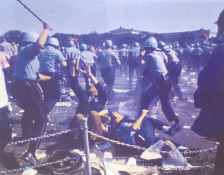 Rioters at
the Democrat Convention Rioters at
the Democrat Convention | The anti-war protesters did not like Humphry because he had supported President Johnson
and they did not want to see him nominated to run for president. The chaos and violence of 1968
climaxed in Chicago. Thousands of antiwar demonstrators converged on the city to protest at the
Democratic National Convention in August of that year. The contest was now between Eugene
McCarthy and Vice-President Hubert Humphrey. McCarthy, while still popular with the nation’s
antiwar segment, but he had little chance of defeating Humphrey, a loyal party man who had President
Johnson’s support. During the last week of August, | As the delegates
arrived in Chicago, so too did nearly 10,000 protesters . Led by men such as SDS veteran Tom Hayden,
many demonstrators sought to pressure the Democrats into adopting an antiwar platform . Others came
to voice their displeasure with Humphrey’s nomination . Still others, known as Yippies (members
of the Youth International Party), had come hoping to provoke violence that might discredit the
Democratic Party. Chicago’s mayor, Richard J. Daley, was determined to keep the protesters
under control . With memories of the nationwide riots after King’s death still fresh, Daley
mobilized 12,000 Chicago police officers and 5,000 National Guardsmen. “As long as I am
mayor,” Daley vowed, “there will be law and order.”
Riots broke out and the Chicago police put them down with
force. People watched on television and rioters and police fought outside the convention hall.
Disorder of a different kind reigned inside the convention hall, where delegates bitterly debated an
antiwar plank in the party platform. When word of the riot filtered into the hall, delegates
angrily shouted at Daley, who returned their shouts with equal vigor. The whole world indeed was
watching-on their televisions . The images of the Democrats-both inside and outside the convention
hall-as a party of disorder became etched in the minds of millions of
Americans | | |
|
|
|
137.
|
Who was the leading Democrat in
the race for president at the Democrat convention?
a. | Eugene
McCarthy | c. | Tom
Hayden | b. | Richard Nixon | d. | Hubert Humphry |
|
|
|
138.
|
Which of the candidates was a
supporter of President Johnson?
a. | Hubert
Humphry | c. | Tom
Hayden | b. | Eugene McCarthy | d. | Bobby Kennedy |
|
|
|
139.
|
Who was the mayor of Chicago
who gave the order to quell the rioters in Chicago?
a. | Tom
Hayden | c. | Hubert
Humphry | b. | Richard Daily | d. | Abby Hoffman |
|
|
|
140.
|
There was a debate raging
inside the convention also. What were the delegates arguing about?
a. | Whether the party would be pro or
anti war | c. | Whether they
should nominate Tom Hayden of Richard Nixon | b. | How much they should increase social
security | d. | Whether or not Johnson should run
again |
|
|
|
141.
|
Millions of people watched the
Democrat convention on television. What impression did the people get of the democrat
party.
a. | the Democrats were organized and in
control. | c. | the Democrats were
out of control and unorganized | b. | the Democrats were very democratic | d. | the Democrats were organized |
|
|
|
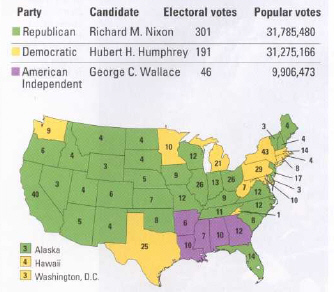 | 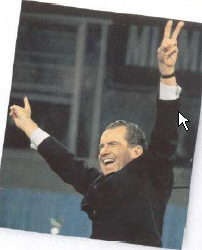
Republican Nixon Wins | In the 1960
election John Kennedy and Richard Nixon ran against each other. It was one of the closest elections
in American history. Nixon lost and went back to California where he ran for Governor. Nixon lost
that election also and everyone thought he was finished in politics.
At the Republican
convention Nixon announced that he would run for president. He had a great deal of support in the
Republican party and he said his main issue was to restore law and order in the United States. He
said he would, “bring us together.” He also said that he had a plan to win the war
in Vietnam and would bring an end to that war. Nixon won the nomination of the Republican party. The
millions of people who watched the Republican convention saw a well organized convention free of
chaos and riots.
Another person ran for president in 1968. George Wallace was a democrat and
the Governor of Alabama. He was also a segregationist who tried to keep black students from entering
the University of Alabama. Wallace did not like the people who were in control of the Democrat party
so he decided to leave the Democrat party and run as the American Independent party candidate. He had
many supporters in the Democrat party so this took support from Hubert Humphry, the Democrat
candidate.
So, the race for president was between three
candidates in 1968;
Hubert Humphry, democrat;
George Wallace, American Independent; and
Richard Nixon, Republican.
In the U.S. each state is given a certain number of votes for president. These
votes are called electoral votes and you need a majority of them to be elected. In the end, Nixon
defeated Humphrey by more than 100 electoral votes. By winning the presidency Richard Nixon inherited
the quagmire in Vietnam. He eventually would end America's involvement in Vietnam but it would
take him another 4 years..
| | |
|
|
|
142.
|
To the millions of people
watching the conventions on television in 1968, which party seemed to be the most organized and able
to run the country.
a. | Republicans | c. | American Independence | b. | Democrats | d. | none of them |
|
|
|
143.
|
Which candidate won more
electoral votes than the other two candidates combined?
a. | Humphry | c. | Nixon | b. | Wallace | d. | none of them |
|
|
|
144.
|
George Wallace had a history of
anti-black going back to the time he tried to block black students from entering the University of
Alabama. If it can be said that George Wallace was the anti-black candidate. What do the election
results of 1968 say about racism in America?
a. | The South was the only part of the
country that voted to support African Americans. | c. | Except for the South, when given the chance to vote against African Americans,
most Americans refused to do so. | b. | Except for the North and West, when given the chance to vote against African
Americans, most Americans refused to do so | d. | Most Americans voted to support candidates who were
anti-black |
|
|
|
145.
|
Which candidate ran against
John F. Kennedy and later Hubert Humphry?
a. | Richard
Nixon | c. | Lyndon
Johnson | b. | Gene McCarthy | d. | Tom Haydon |
|
|
|
146.
|
Which candidate split the
Democrat party by leaving and running as an independent?
a. | Gene
McCarthy | c. | George
Wallace | b. | Hubert Humphry | d. | Tom Haydon |
|
|
|
The End of the War
President Nixon and
Vietnamization
President Nixon took office in 1969 and wanted to end the war. Right away he
announced that some American troops would be withdrawn from Vietnam. He thought this might be a peace
overture to North Vietnam but the Communists did not show any signs toward peace. Nixon then
continued the war against North Vietnam to achieve what he called “peace with
honor
THE PULLOUT BEGINS President Johnson had started
negotiations with North Vietnam to end the war. The talks took place in Paris. President Nixon continued the talks after he took office
but the talks were going nowhere. The United States and South Vietnam insisted that all North
Vietnamese forces withdraw from the South and that the government of Nguyen Van Thieu, then South
Vietnam’s ruler, remain in power. The North Vietnamese and Vietcong demanded that U.S. troops
withdraw from South Vietnam and that the Thieu government step aside for a coalition government that
would include the Vietcong .
In the
midst of the stalled negotiations, Nixon announced his strategy to end America’s involvement in
Vietnam. Known as Vietnamization, the plan called for the gradual withdrawal of U .S . troops
in order for the South Vietnamese to take on a more active combat role in the war. By August of 1969,
the first 25,000 U.S. troops had returned home from Vietnam . Over the next three years, the number
of American troops in Vietnam dropped from more than 500,000 to less than 25,000. Nixon was keeping
his promise to end the war in Vietnam
“PEACE WITH
HONOR”
However, part of
Nixon’s Vietnamization policy was aimed at establishing what he called a “peace with
honor.” Nixon intended to maintain U .S. dignity in the face of its withdrawal from war. A
further goal was to keep America strong in the negotiations North Vietnam. President Nixon still
demanded that the South Vietnamese government remain intact. North Vietnam continued to use the Ho
Chi Minh trail to supply the Vietcong in the South. | | The North Vietnamese could use the trail without worrying
about being attacked because we did not want to Laos and Cambodia, which were neutral countries.
Nixon felt he had to stop the supplies to the South so he secretly ordered a massive bombing campaign
against supply routes and bases in North Vietnam The president also ordered that bombs be dropped on
the Ho Chi Minh trail in the neighboring countries of Laos and Cambodia, which held a number of
Vietcong sanctuaries. Nixon told aide H. R. Haldeman that he wanted the enemy to be afraid of the
U.S. |  President Nixon plans
strategy in Vietnam President Nixon plans
strategy in Vietnam | | |
|
|
|
147.
|
President Nixon reduced the
American troops in Vietnam by _____
a. | 25,000 | c. | 475,000 | b. | 125,000 | d. | 525,000 |
|
|
|
148.
|
Nixon wanted to pull the U.S.
out of the war but he did not want to desert the people of South Vietnam and he did not want it to
look like the U.S. was defeated. What labile did Nixon put on this policy?
a. | Peace with
Honor | c. | Vietcong
peace | b. | Peace at any cost | d. | Paris treaty |
|
|
|
149.
|
Who was the president of South
Vietnam when Nixon took office?
a. | Ho Chi
Minh | c. | Mao | b. | Nguyen Van Thieu | d. | Chaing |
|
|
|
150.
|
Nixon wanted the South
Vietnamese to take over the fighting so the American troops could be pulled out. This policy was
called _____
a. | Peace with
honor | c. | Peach
now | b. | Vietnamization | d. | North Vietnamization |
|
|
|
151.
|
Why did Nixon decide to bomb
Laos, Cambodia and North Vietnam?
a. | stop the supplies through the Ho Chi
Minh trail | d. | all of
these | b. | Make North Vietnam fear and respect him | e. | only two of these answers are correct | c. | make the U.S, stronger in the negotiations with North
Vietnam |
|
|
|
Seeking to win support for his war policies, Richard Nixon appealed to what he
called the silent majority-moderate, mainstream Americans who quietly supported the president’s
strategy. To be sure, many average Americans did support the president. However, the events of the
war continued to divide the country.
HE MY LAI
MASSACRE
In November of 1969,
Americans learned of a shocking event. On March 16, 1968, a U.S . platoon under the command of
Lieutenant William Calley Jr., entered the small village of My Lai in northern South Vietnam in
search of Vietcong rebels .The troops rounded up the villagers and shot them . In all, the soldiers
massacred more than 100 innocent Vietnamese-mostly women and children.
The troops insisted that
they were following Lieutenant Calley’s orders . When asked what his directive had been, one
soldier answered, “Kill anything that breathed.” Twenty-five army officers were charged
with involve- ment in the massacre and subsequent cover-up, but only Calley was convicted and
imprisoned . The My Lai massacre shook the nation’s conscience
THE INVASION OF CAMBODIA AND KENT STATE
The country’s mood by 1970 seemed to be growing less
explosive. American troops were on their way home, and it appeared that the war was finally winding
down. In 1969 many students were shifting their attention from the antiwar movement to the
environment .
Then on April 30, 1970, President Nixon announced that U.S . troops had invaded
Cambodia. President Nixon said the “incursion” into Cambodia was launched, to clear out
North Vietnamese and Vietcong supply centers.
Upon hearing of the invasion, college students across the
country erupted in protest. In what became the first general student strike in the nation’s
history, more than 1.5 million students closed down some 1,200 campuses . Disaster struck hardest at
Kent State University in Ohio, where a massive student protest led to the burning of the ROTC
building . In response to the growing unrest, the local mayor called in the National Guard. On May 4,
1970, the guards fired into a crowd of campus protesters who were hurling rocks at them. The gunfire
wounded nine people and killed four, including two who had not even participated in the rally. Ten
days later, similar violence rocked the mostly all-black college of Jackson State in Mississippi.
National Guardsmen there confronted a group of antiwar demonstrators and fired on the crowd after ;
| | several bottles
were thrown . In the hail of bullets, 12 students were wounded and 2 were killed, both innocent
bystanders . Polls indicated that many Americans supported the National Guard respondents claimed
that the students “got what they were asking for.” The weeks following the campus turmoil
brought new attention to a group known as “hardhats,” construction workers and other
blue-collar Americans who supported the U.S. government’s war policies . In May of 1970, nearly
100,000 members of the Building and Construction Trades Council of New York held a rally outside city
hall to support the government. | 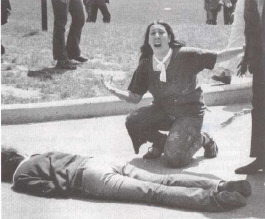 | | |
|
|
|
152.
|
Who was responsible for the My
Lai Massacre?
a. | North
Vietnam | c. | 100 Vietnamese
villagers | b. | The Vietcong | d. | A platoon of U.S. soldiers |
|
|
|
153.
|
The officer responsible to My
Lai was named _____ and he was _____ by the U.S. government
a. | William Calley - set
free | c. | Nguyen Van Thieu - put in prison | b. | Lieutenant William Calley Jr - imprisoned | d. | President Nixon - impeached |
|
|
|
154.
|
The mood in the colleges seemed
to be calming down in 1970. It seemed that the U.S. was pulling out of Vietnam. What got the students
fired up and protesting again?
a. | My Lai
Massacre | c. | Nixon said they
had to have passing grades to continue as students | b. | Bombing of Laos and
Cambodia | d. | The colleges wanted the students to
pay tuition |
|
|
|
155.
|
The great majority of the
American people did not protest or demonstrate against the war. They wanted the U.S. to end the war
in Vietnam but they supported the government and President Nixon because they believed he was doing
what needed to be done for the good of the country.
What were these supporters
called?
a. | Hard
Hats | c. | Mothers for
Peach | b. | SDS | d. | Silent
Majority |
|
|
|
156.
|
Why did president Nixon invade
Cambodia?
a. | He wanted to cut off supplies to the
Vietcong in South Vietnam | c. | He wanted to cut off supplies to North
Vietnam | b. | He wanted to free those countries from
Communism | d. | He wanted to make them part of
greater Vietnam |
|
|
|
THE PENTAGON
PAPERS
Nixon’s
Cambodia policy cost him significant political support. By first bombing and then invading Cambodia
without even notifying Congress, the president stirred anger on Capitol Hill (Congress). On December
31, 1970, Congress repealed the Tonkin Gulf Resolution, which had given the president near
independence in conducting policy in Vietnam .
In June of 1971 former Defense
Department worker named Daniel Ellsberg stole secret papers about the Vietnam war from the government
and gave them to a newspaper. These papers became known as the Pentagon Papers . The
7,000-page document, written for Defense Secretary Robert McNamara, revealed that the government drew
up plans for entering the war even as President Lyndon Johnson promised that he would not send
American troops to Vietnam . Furthermore, the papers showed that there was never any plan to end the
war as long as the North Vietnamese persisted .For many Americans, the Pentagon Papers confirmed
their belief that the government had not been honest about its war intentions . For most Americans
the Pentagon Papers did not mean much because the Pentagon is always drawing up plans. They saw them
as part of the anti-war movement. The document was not particularly damaging to the Nixon
administration. They did show that the Johnson administration was saying one thing in private about
the Vietnam war and another thing in public. Was this dishonest?
| |
|
|
|
157.
|
What does the nickname,
“capital hill” stand for?
a. | the
president | c. | the defense
department | b. | the supreme court | d. | the congress |
|
|
|
158.
|
Since the constitution says
that only congress can declare war, what gave the president the right to send troops to Vietnam to
fight?
a. | the Pentagon
Papers | c. | the Pentagon
Resolution | b. | the Tonkin Gulf Resolution | d. | the war resolution act |
|
|
|
159.
|
The Pentagon Papers showed that
Robert McNamara _____
a. | was honest and in what he told the
President and the American people | c. | may not have been honest with Americans about the Vietnam
war | b. | did not like or trust the Defense Department | d. | did not like Daniel Elsberg |
|
|
|
America’s Longest War Ends
In March of 1972, the North Vietnamese launched their
largest attack on South Vietnam since the Tet offensive in 1968. President Nixon responded by
ordering a massive bombing campaign against North Vietnamese cities, and the mining of
Haiphong’s harbor, into which Soviet and Chinese supply ships sailed . The bombings halted the
North Vietnamese attack, but the grueling stalemate continued . It was after this that the Nixon
administration took steps to finally end America’s involvement in Vietnam
.
“PEACE IS AT HAND”
By the middle of 1972,
the country’s growing social division and the looming presidential election prompted the Nixon
administration to change its negotiating policy in Paris . Polls showed that more than 60 percent of
Americans in 1971 felt that the United States should withdraw all troops from Vietnam by the end of
the year.
Henry Kissinger, the president’s adviser for national security affairs, served as
Nixon’s top negotiator in Vietnam . Kissinger, a German emigrant who had earned three degrees
from Harvard, was an expert on international relations . Since 1969, Kissinger had been meeting
privately with North Vietnam’s chief negotiator, Le Due Tho. Eventually, Kissinger
dropped his insistence on the removal of all North Vietnamese troops from the South before the
complete withdrawal of American troops. On October 26, 1972, one week before the presidential
election, Kissinger announced, “Peace is at hand.”
THE FINAL PUSH
President Nixon won reelection, but the promised peace proved to be elusive .
The Thieu regime, alarmed at the prospect of North Vietnamese troops stationed in South Vietnam,
rejected Kissinger’s plan. Talks broke off on December 16, and two days later, the president
unleashed a ferocious bombing campaign against Hanoi and Haiphong, the two largest cities in North
Vietnam . In what became known as the “Christmas bombings,” U.S . planes dropped
100,000 bombs for 11 straight days, pausing only on Christmas Day.
At this point, members of congress began to demand that
the war be ended. The Soviet Union and China were also demanding that the U.S. pull out of Vietnam.
Everyone, it seemed, had finally grown weary of the war. The warring parties returned to the peace
table, and on January 27, 1973, the United States signed an “agreement on ending the war and
restoring peace in Vietnam.” Under the agreement, North Vietnamese troops would remain in South
Vietnam, which had Nixon’s promise to respond “with full force” to any violation of
the peace agreement. On March 29, 1973, the last U.S. combat troops left for home. For America,
the Vietnam War had ended but the war went on between South Vietnam and North
Vietnam.
THE FALL OF SAIGON
Within
months of the United States’ departure, the cease-fire agreement between North and South
Vietnam collapsed. In March of 1975, after several years of fighting, the North Vietnamese launched a
full-scale invasion against the South. Thieu (president of South Vietnam) appealed to the United
States for help. America provided economic aid but refused to send troops . President Gerald
Ford, who was now president, captured the nation’s mood during a speech in New Orleans:
“America can regain its sense of pride that existed before Vietnam. But it cannot be achieved
by re-fighting a war that is finished as far as America is concerned.” On April 30, 1975, North
Vietnamese tanks rolled into Saigon and captured the city. Soon after, South Vietnam surrendered to
North Vietnam.
| |
|
|
|
160.
|
Vietnam was
a. | America’s shortest
war | c. | America’s bloodiest
war | b. | America’s longest war | d. | Not part of the cold war |
|
|
|
161.
|
What was the key issue between
the U.S. and North Vietnam that prevented an end to the war?
a. | An end to U.S. bombing of North
Vietnam | c. | The placement of
North Vietnam troops in South Vietnam | b. | An end to U.S. bombing of South Vietnam | d. | The placement of South Vietnam troops in North
Vietnam |
|
|
|
162.
|
At the Paris peace talks _____
was the negotiator for the U.S. and _____ was the negotiator for North Vietnam.
a. | Henry Kissinger - Ho Chi
Minh | c. | Robert McNamara - Le Due Tho | b. | George Ball - Cho En Lai | d. | Henry Kissinger - Le Due
Tho |
|
|
|
163.
|
Kissinger and the U.S. finally
agreed to allow North Vietnam troops to be stationed in South Vietnam. North Vietnam now agreed to
sign the peace treaty. What did South Vietnam do?
a. | Agreed to end the fighting
| c. | Asked the U.N to take up the
issue | b. | Refused to agree with North troops in the South and continued
fighting. | d. | Bombed North
Vietnam |
|
|
|
164.
|
All of the following groups
were demanding that the U.S. pull out of Vietnam except
a. | Soviet
Union | d. | North Vietnam
| b. | Communist
China | e. | South Vietnam | c. | Liberal Members of
Congress |
|
|
|
165.
|
After the U.S. finally pulled
out of Vietnam, what happened next?
a. | There was peace throughout
Vietnam | c. | Within months
North Vietnam and South Vietnam began to fight again | b. | The U.S. continued bombing, even though American troops
had been withdrawn. | d. | The North and South retreated behind
their borders |
|
|
|
166.
|
In 1975 North Vietnam was
pushing to take over South Vietnam. President Thieu asked the U.S.
president for help. What did the president of the U.S. do.
a. | told him to
surrender | c. | sent American
planes to bomb the North | b. | offered money, medicine and supplies but no U.S.
troops | d. | sent in U.S.
troops |
|
|
|
167.
|
Who was president of the United
States when the war finally ended for the U.S.?
a. | Richard
Nixon | c. | Gerald
Ford | b. | Jimmy Carter | d. | Henry Kissinger |
|
|
|
VIETNAM’S EFFECT ON AMERICA
Even
after it ended, the Vietnam War remained a subject of great controversy for Americans. Many hawks
continued to insist that the war could have been won if the U.S. had employed more military power.
They also blamed the antiwar movement at home for destroying American morale. Doves countered
that the North Vietnamese had displayed incredible resiliency and that an increase in U.S. military
force would have resulted only in a continuing stalemate. In addition, doves argued that an
unrestrained war against North Vietnam might have prompted a military reaction from China or the
Soviet Union and a World War | 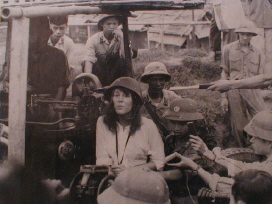 Jane Fonda visiting North Vietnam and sitting at an anti-aircraft gun used to
shoot down American aircraft Jane Fonda visiting North Vietnam and sitting at an anti-aircraft gun used to
shoot down American aircraft | The war resulted
in several major U.S . policy changes. First, the government abolished the draft, which had stirred
so much antiwar sentiment. The country also took steps to curb the president’s war-making
powers. In November 1973, Congress passed the War Powers Act, which stipulated that a
president must inform Congress within 48 hours if U. S. forces are sent into a hostile area without a
declaration of war. In addition, the troops may remain there no longer than 90 days unless Congress
approves the president’s actions or declares war. In a broader sense, the Vietnam War
significantly altered America’s views on foreign policy. In what has been labeled the
Vietnam syndrome, Americans now pause and consider possible risks to their own interests
before deciding whether to intervene in the affairs of other nations. Many thought the U.S. lost the
war in Vietnam and they did not want to suffer another defeat.
The war led to a deep division
between liberal and conservative groups in the United States. The moral of the country was low and
some doubted America’s role in the world as a great nation. Many people called people like Jane
Fonda (movie star) and other antiwar activist’s traitors to the United States for supporting
North Vietnam while we were at war. The country had to wait another five or six years for Ronald
Reagan to become president and restore America’s confidence. | | |
|
|
|
168.
|
What effect did the Vietnam war
have on American morale and belief in itself?
a. | damaged
it | c. | no effect at
all | b. | helped it | d. | improved American confidence |
|
|
|
169.
|
During the Vietnam war America
was concerned with the involvement of the Soviet Union and Communist China. Why?
a. | A confrontation could provoke World
War III | c. | We were afraid
that China and the Soviets would get into a war. | b. | The Soviets and China were good trading partners of the
U.S. | d. | We did not want the Soviets and China to get kicked out of
the U.N. over Vietnam |
|
|
|
170.
|
Which law, passed by congress
after Vietnam, restricted the presidents ability to make war on his own without
congress.
a. | Vietnamization
Act | c. | Vietnam War
Act | b. | War Powers Act | d. | Presidential War Restriction Act |
|
|
|
171.
|
What do they call it when the
U.S. acts nervous about getting involved in wars or the affairs of other countries, even if it
is necessary to protect America.
a. | Vietnamization | c. | Vietnam involvement anxiety | b. | war powers anxiety | d. | Vietnam syndrome |
|